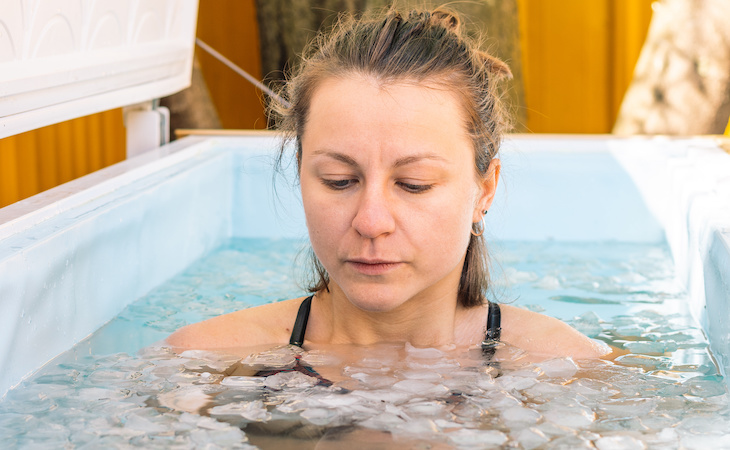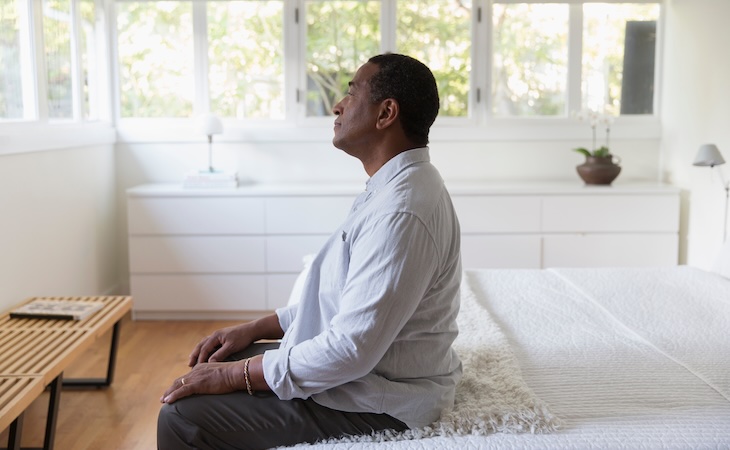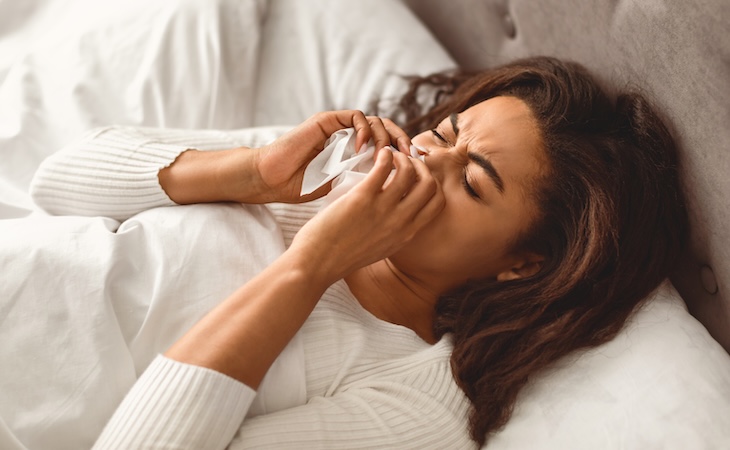I’ve been willingly submerging myself in sub-40 degree Fahrenheit water two to four times per week for the last four-ish months. And while I originally sought out cold therapy for completely different reasons, I’ve been pleasantly surprised to find that the exposure to the cold has helped me get some of the best sleep of my life.
But how, exactly, is plunging into near-freezing water helping me sleep better at night—and wake up feeling more refreshed in the morning? Let’s take a look at everything you need to know about cold therapy: what it is, how it can impact sleep, and how you can (safely!) incorporate cold exposure into your own sleep hygiene routine.
What is cold therapy?
Cold water therapy (also known as cold therapy or cold exposure) is a practice that involves submerging most of your body in extremely cold water. Which, as it turns out, causes a cascade of effects in the body—many of which have a positive impact on both physical and mental health (more on those benefits in a minute).
While it’s possible to do cold water therapy on your own, I do mine at a local wellness center. Each session starts off with breathwork—and after a few deep inhales and exhales, I get into the cold plunge. The tub is about as long as I am tall (I’m 5’6”, for reference), with a wooden exterior and aluminum interior, and the water inside is typically about 37 degrees (there are often chunks of ice in the water when I get in!).
Once I’m in the tub, I submerge myself up to my neck in the water, leaving my hands and fingers above the water, as your extremities get cold faster than the rest of your body (the wellness center provides booties to cover your toes). Then, I sit and settle into the experience.
So, what’s it like? When you first get in the cold plunge, your body pretty much screams for you to get out—and your body activates the sympathetic nervous system. Or, in other words, you go into “fight-or-flight” mode.
“As it activates, you get this massive release of adrenaline and cortisol—and so your body is ramped up,” says Bryan Call, doctor of chiropractic and owner of Cell Regen, a wellness center focused on longevity (and the center where I do my cold plunges).
But if you can sit through that initial fight-or-flight response (which generally takes about three and a half minutes), “the sympathetic stimulation and drive become exhausted and your parasympathetic then can begin to take over,” says Call.
Once your parasympathetic nervous system (aka rest and digest) kicks in, the stress you initially feel getting in the water gives way to a much more centered, meditative experience.
After I’ve been in the water for a while (generally, my goal is seven to seven and a half minutes), I get out of the cold plunge and immediately get into a sauna (a practice known as cold therapy), where I warm up for about 10 minutes. Then, it’s back in the water for another quick dip (complete with an underwater head dunk!), and voila—that’s a wrap on my session. (Here’s how to biohack your sleep.)
What are the benefits of cold therapy?
There isn’t a ton of research on the benefits of cold water therapy—but there are studies that suggest that cold plunges may help improve immune function, lower inflammation, and improve recovery. And those aren’t the only potential benefits.
“When you expose yourself to the cold, your body accommodates and adapts,” says Call. “It increases your body’s ability to regulate temperature…and it trains and strengthens the cardiovascular system.”
Cold therapy also causes blood vessels to constrict, which prompts the lymphatic system to flush fluid through the body—removing toxins in the process. “It’s very much a detoxifying process,” says Call.
Cold exposure may also help with mood and stress—thanks to the neurotransmitters released while you’re submerged in the cold water.
“You get about a 300 to 500% boost of [norepinephrine]…[which] basically makes cortisol unusable to activate how it normally does for about four to six hours,” says Call. “And then you get the release of dopamine, which is our…pleasure reward center in the brain that makes you feel great.”
There’s also a mental benefit that comes with sticking with the cold plunge—despite the extreme discomfort you’ll likely feel when you first get in.
“Your body is screaming out with everything it has for you to escape, and you just say, ‘Thanks buddy, thanks for sharing. I’m just going to go ahead and stay in here,’” says Call. “You literally build resiliency…and that mental capacity and knowledge carries with you so far out of just doing a cold plunge.”
As mentioned, more research needs to be done into the effects of cold therapy. But anecdotally, I can say I’ve seen huge benefits, both to my physical and mental health, as a result of my time spent cold plunging. I feel more energetic. My mood is better. I feel stronger and more resilient. And I have less pain and feel better in my body (which, for someone living with rheumatoid arthritis, is a big deal).
Is cold therapy good for sleep?
But, as I mentioned, one of the more unexpected benefits I’ve experienced from cold therapy is I’ve been getting way better sleep. I’ve had an easier time falling asleep, I’ve been sleeping more deeply, and I’ve been waking up feeling more refreshed than I have in a long time.
While there isn’t a ton of research on how cold immersion impacts sleep, when I spoke to Call, he had the same experience.
“I have my Oura Ring tracker [data] and I got about a 35% increase of my deep cycle delta wave sleep when I was doing my cold plunges—and about a 25% increase of my REM cycle,” says Call.
Anecdotally, I can say I’ve seen huge benefits, both to my physical and mental health, as a result of my time spent cold plunging. I feel more energetic. My mood is better. I feel stronger and more resilient. And I have less pain and feel better in my body (which, for someone living with rheumatoid arthritis, is a big deal).
Part of the reason why cold plunges may help with sleep has to do with the impact on the nervous system. “You’re activating and releasing a lot more of those parasympathetic hormones that cause your body to be calm in the moment and relaxed,” explains Call. “It’s prepping yourself for a much deeper sleep into the night.”
(Just make sure not to do cold plunges too close to bedtime; because you feel energized immediately following your cold therapy, getting in the water too late into the evening might make it harder to initially fall asleep.)
How to try cold therapy safely
Interested in giving cold water therapy a try? Here are a few tips to get started—and get started safely:
- Start with a bowl of water… If you want to try cold therapy—but aren’t ready to take the full plunge—start small. “The easiest [way to get started]…is to get a large salad bowl, fill it up with cold water, and dump a bunch of ice into it, and you put your face into it,” says Call.
- …and then progress to a tub. If you’re ready to try immersing your entire body, fill your tub with cold water from the faucet, which is generally about 50 degrees. As you get more comfortable with that temperature, you can experiment with making the water colder by adding ice.
- Time it right. You don’t need to be in the cold water for long to reap the benefits. According to Call, anywhere between three and seven minutes is ideal. (Depending on the temperature of the water, staying in much longer could put you at risk for hypothermia.) “Keep it short,” says Call. “If you’re just looking for physiological benefits, you’re going to get everything you need in under seven [minutes],” says Call.
- Have someone nearby. Whether you’re plunging in your bathtub, at a wellness center, or outside in a river or lake, make sure to “always have a spotter to be safe,” says Call.
FAQs
What does cold therapy do for you?
Cold therapy causes a variety of physiological effects in the body—many of which may offer benefits to your physical and mental health, including improved sleep, improved immune function, lowering inflammation, and improved mood.
What’s an example of cold therapy?
Cold therapy could include immersing yourself in cold water in your bathtub, cold plunging at a wellness center, or plunging outdoors—for example, in a river or lake. (Just make sure to have someone nearby for safety reasons.)
Who shouldn’t use cold therapy?
Cold therapy may not be right for people with cardiovascular issues, high blood pressure, open wounds, and/or mobility issues. Anyone experiencing these issues should consult their doctor before trying cold therapy.
Beyond cold therapy, there are plenty of other buzzy treatments you can try to improve your snooze. Check out our roundup of the best trendy wellness treatments for sleep to see if any of them are right for you.




